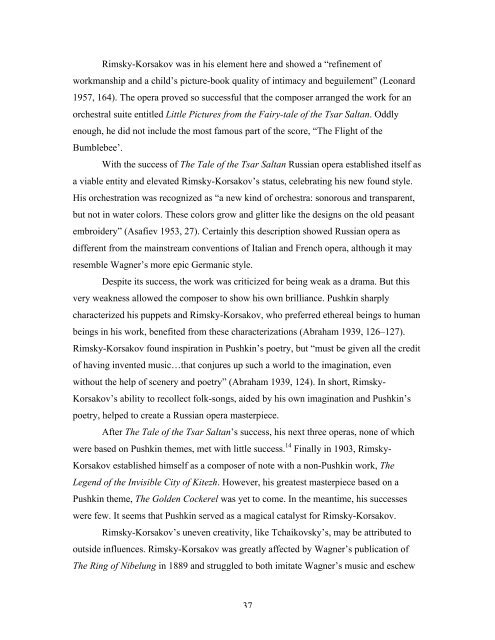Alexander Pushkin's Influence on Russian Ballet
Alexander Pushkin's Influence on Russian Ballet
Alexander Pushkin's Influence on Russian Ballet
You also want an ePaper? Increase the reach of your titles
YUMPU automatically turns print PDFs into web optimized ePapers that Google loves.
Rimsky-Korsakov was in his element here and showed a “refinement of<br />
workmanship and a child’s picture-book quality of intimacy and beguilement” (Le<strong>on</strong>ard<br />
1957, 164). The opera proved so successful that the composer arranged the work for an<br />
orchestral suite entitled Little Pictures from the Fairy-tale of the Tsar Saltan. Oddly<br />
enough, he did not include the most famous part of the score, “The Flight of the<br />
Bumblebee’.<br />
With the success of The Tale of the Tsar Saltan <strong>Russian</strong> opera established itself as<br />
a viable entity and elevated Rimsky-Korsakov’s status, celebrating his new found style.<br />
His orchestrati<strong>on</strong> was recognized as “a new kind of orchestra: s<strong>on</strong>orous and transparent,<br />
but not in water colors. These colors grow and glitter like the designs <strong>on</strong> the old peasant<br />
embroidery” (Asafiev 1953, 27). Certainly this descripti<strong>on</strong> showed <strong>Russian</strong> opera as<br />
different from the mainstream c<strong>on</strong>venti<strong>on</strong>s of Italian and French opera, although it may<br />
resemble Wagner’s more epic Germanic style.<br />
Despite its success, the work was criticized for being weak as a drama. But this<br />
very weakness allowed the composer to show his own brilliance. Pushkin sharply<br />
characterized his puppets and Rimsky-Korsakov, who preferred ethereal beings to human<br />
beings in his work, benefited from these characterizati<strong>on</strong>s (Abraham 1939, 126–127).<br />
Rimsky-Korsakov found inspirati<strong>on</strong> in Pushkin’s poetry, but “must be given all the credit<br />
of having invented music…that c<strong>on</strong>jures up such a world to the imaginati<strong>on</strong>, even<br />
without the help of scenery and poetry” (Abraham 1939, 124). In short, Rimsky-<br />
Korsakov’s ability to recollect folk-s<strong>on</strong>gs, aided by his own imaginati<strong>on</strong> and Pushkin’s<br />
poetry, helped to create a <strong>Russian</strong> opera masterpiece.<br />
After The Tale of the Tsar Saltan’s success, his next three operas, n<strong>on</strong>e of which<br />
were based <strong>on</strong> Pushkin themes, met with little success. 14 Finally in 1903, Rimsky-<br />
Korsakov established himself as a composer of note with a n<strong>on</strong>-Pushkin work, The<br />
Legend of the Invisible City of Kitezh. However, his greatest masterpiece based <strong>on</strong> a<br />
Pushkin theme, The Golden Cockerel was yet to come. In the meantime, his successes<br />
were few. It seems that Pushkin served as a magical catalyst for Rimsky-Korsakov.<br />
Rimsky-Korsakov’s uneven creativity, like Tchaikovsky’s, may be attributed to<br />
outside influences. Rimsky-Korsakov was greatly affected by Wagner’s publicati<strong>on</strong> of<br />
The Ring of Nibelung in 1889 and struggled to both imitate Wagner’s music and eschew<br />
37

















